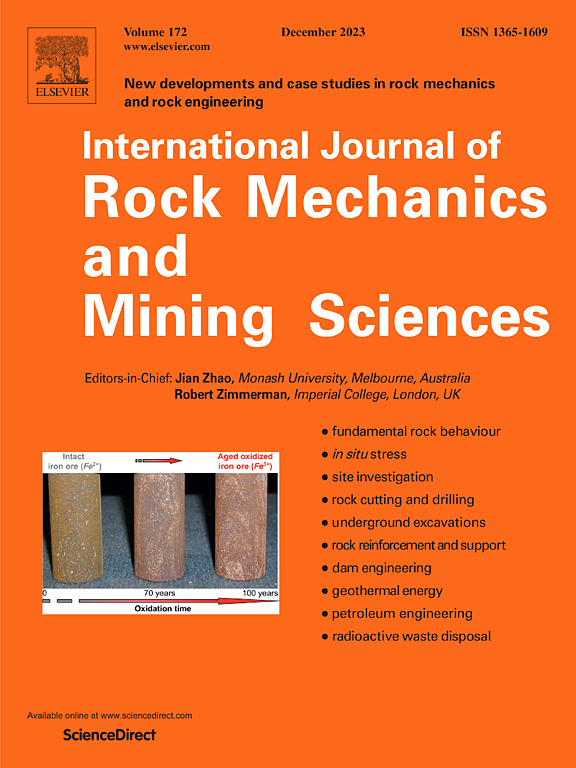循环高压脉冲放电对岩石等离子体通道形成机制的影响及其对岩石强度削弱作用的定量评价
IF 7
1区 工程技术
Q1 ENGINEERING, GEOLOGICAL
International Journal of Rock Mechanics and Mining Sciences
Pub Date : 2025-04-23
DOI:10.1016/j.ijrmms.2025.106121
引用次数: 0
摘要
高压电脉冲(HVEP)技术有望彻底改变深部资源开采和地下空间工程建设技术。了解等离子体通道的建立机理和脉冲放电对岩石力学特性的影响是该技术广泛应用的关键。本文对砂岩进行了循环放电试验。随后,对实验后岩样进行波速测试和单轴压缩测试,定量评价循环放电对岩石力学性能的弱化规律。同时,利用计算机断层扫描(CT)、扫描电镜(SEM)和能量色散光谱(EDS)分析了砂岩内部等离子体通道的形成机制,探讨了脉冲放电对岩石强度的削弱机制。结果表明:随着循环放电次数的增加,峰值电流、电流在砂岩中的传播时间和岩石破碎程度均有所增加;循环放电降低了岩石的纵波速度(Vp)、单轴抗压强度(UCS)和弹性模量(E)。CT扫描结果表明,在第一次放电后,岩石中建立了等离子体通道。通过扫描电镜观察,发现等离子体通道内的岩石存在晶间和粒内裂纹,而外部的岩石则完好无损。此外,等离子体通道表面的EDS分析显示,循环放电形成了类似酸性岩浆的物质,表明放电在岩石中产生了高温。高温和激波的协同作用导致了等离子体通道的发育和岩石的电破碎。然而,高温效应仅限于等离子体通道区域内。研究结果为深入理解HVEPs作用下岩石的破坏过程提供了有价值的见解。本文章由计算机程序翻译,如有差异,请以英文原文为准。
Impact of cyclic high-voltage pulse discharge on the formation mechanism of rock plasma channels and quantitative assessment of its weakening effect on rock strength
High voltage electric pulse (HVEP) technology is expected to revolutionize deep resource extraction and underground space engineering construction technology. Understanding the establishment mechanism of the plasma channel and the pulsed discharge impact on the mechanical characteristics of rock is considered key to the widespread utilization of this technology. In this work, cycle discharge experiments on sandstone were carried out. Subsequently, the post-experiment rock samples were tested for wave velocity and uniaxial compression tests to quantitatively evaluate the weakening law of the rock's mechanical properties due to cyclic discharge. Concurrently, the formation mechanism of plasma channels within the sandstone was analyzed using Computed Tomography (CT), Scanning Electron Microscopy (SEM) and Energy-Dispersive Spectroscopy (EDS), whereas the weakening mechanism of rock strength by pulsed discharge was discussed. The results demonstrated that the peak current, propagation time of the current in sandstone, and the degree of rock fragmentation increased with the number of cycle discharges. The cycle discharges decreased the P-wave velocity (Vp), uniaxial compressive strength (UCS), and elastic modulus (E) of the rocks. The CT scan results indicated the plasma channel was established in the rock after the first discharge. According to the SEM observations, the existence of intergranular and intragranular cracks in the rock in the plasma channel was revealed, while the rock outside remained undamaged. In addition, the EDS analysis of the plasma channel surface revealed that the cycle discharges formed substances similar to acidic magma, suggesting that the discharge generated high temperatures in the rock. The synergistic action of the high temperature and shock waves leads to the development of plasma channels and the electricfragmentation of rocks. However, the high-temperature effect is limited within the zone of the plasma channels. The research results provide valuable insights into deeply understanding the destruction process of rocks under the application of HVEPs.
求助全文
通过发布文献求助,成功后即可免费获取论文全文。
去求助
来源期刊
CiteScore
14.00
自引率
5.60%
发文量
196
审稿时长
18 weeks
期刊介绍:
The International Journal of Rock Mechanics and Mining Sciences focuses on original research, new developments, site measurements, and case studies within the fields of rock mechanics and rock engineering. Serving as an international platform, it showcases high-quality papers addressing rock mechanics and the application of its principles and techniques in mining and civil engineering projects situated on or within rock masses. These projects encompass a wide range, including slopes, open-pit mines, quarries, shafts, tunnels, caverns, underground mines, metro systems, dams, hydro-electric stations, geothermal energy, petroleum engineering, and radioactive waste disposal. The journal welcomes submissions on various topics, with particular interest in theoretical advancements, analytical and numerical methods, rock testing, site investigation, and case studies.

 求助内容:
求助内容: 应助结果提醒方式:
应助结果提醒方式:


